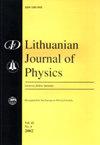金属卤化物立方钙钛矿CsBX3 (B = Ge, Sn, Pb, X = Cl, Br, I)电子和热电性质的计算研究
IF 0.3
4区 物理与天体物理
Q4 PHYSICS, MULTIDISCIPLINARY
引用次数: 1
摘要
近年来,金属卤化物钙钛矿在新的应用领域受到了极大的关注。这些材料在光伏、光子和光电方面的应用正在充分展开,同时热电也引起了人们极大的兴趣。在这项工作中,我们将重点研究金属卤化物立方钙钛矿CsBX3 (B = Ge, Sn, Pb和X = Cl, Br, I)的热电性质。CsBX3的结构和电子性质是使用基于密度泛函理论的第一性原理计算计算的,该理论允许计算平衡晶格参数,能带结构,性质(直接/间接)和带隙值。这些化合物是具有直接带隙能的半导体。我们还检测了用其他卤素和金属阳离子原子取代卤素和金属阳离子原子对电子和热电性能的影响。进行玻尔兹曼输运计算,以探索其热电性质,如塞贝克系数,电导率和功率因数。从这些化合物得到的塞贝克系数和功率因数的大值表明,这些化合物可以用于热电器件。我们对这些化合物的电子和热电性能的理论分析表明,CsSnBr3和CsGeBr3是具有高热电性能的最佳无铅无机金属卤化物半导体。本文章由计算机程序翻译,如有差异,请以英文原文为准。
A computational study of the electronic and thermoelectric properties of metal halide cubic perovskites CsBX3 (B = Ge, Sn, Pb and X = Cl, Br, I)
Metal halide perovskites have received a tremendous interest recently in new applications. Photovoltaic, diverse photonic and optoelectronic applications of these materials are in full expansion, but thermoelectricity also instigates a great interest. In this work, we will focus on the thermoelectric properties of a particular material family of metal halide cubic perovskites CsBX3 (B = Ge, Sn, Pb and X = Cl, Br, I). The structural and electronic properties of CsBX3 are computed using first-principles calculations based on the density functional theory which allows calculating equilibrium lattice parameters, band structures, the nature (direct/indirect) and value of the band gap. These studied compounds are semiconductors with direct band gap energy. We have also detected the effect of replacement of halogen and metal cation atoms with other halogen and metal cation atoms on electronic and thermoelectric properties. Boltzmann transport calculations are carried out to explore their thermoelectric properties like the Seebeck coefficient, electrical conductivity and power factor. Large values of the Seebeck coefficient and the power factor obtained for these compounds indicate that these compounds can be used for thermoelectric devices. Our theoretical analysis of the electronic and thermoelectric properties of these compounds suggests that CsSnBr3 and CsGeBr3 are the best Pb-free inorganic metal halide semiconductor for a high thermoelectric performance.
求助全文
通过发布文献求助,成功后即可免费获取论文全文。
去求助
来源期刊

Lithuanian Journal of Physics
物理-物理:综合
CiteScore
0.90
自引率
16.70%
发文量
21
审稿时长
>12 weeks
期刊介绍:
The main aim of the Lithuanian Journal of Physics is to reflect the most recent advances in various fields of theoretical, experimental, and applied physics, including: mathematical and computational physics; subatomic physics; atoms and molecules; chemical physics; electrodynamics and wave processes; nonlinear and coherent optics; spectroscopy.
 求助内容:
求助内容: 应助结果提醒方式:
应助结果提醒方式:


